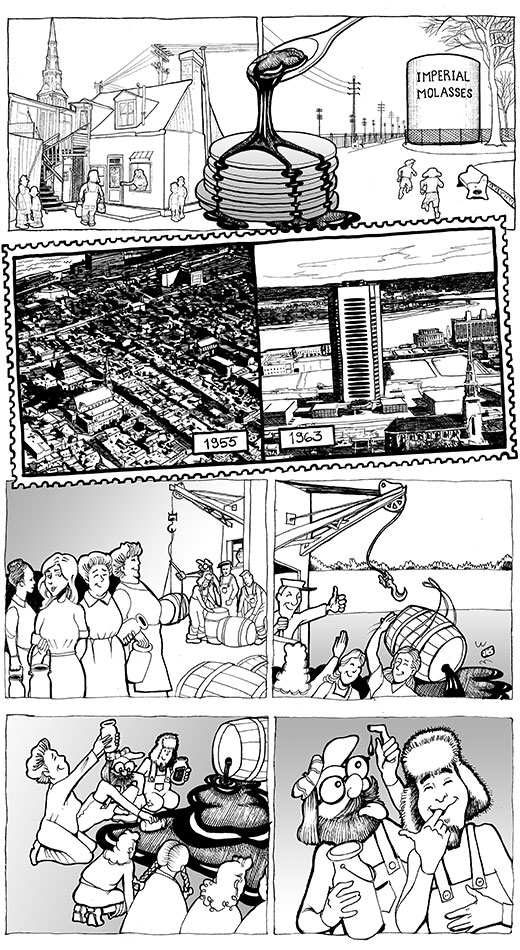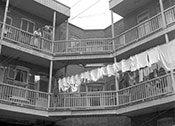 | 1955Mayday and Stevie come from the longshoremen neighborhood known as the Faubourg à m’lasse, the Molasses District. Molasses, as in the heavy syrup with the intense taste created from sugarcane sap. A strong smell of molasses hovers around that neighborhood, emanating from the nearby refineries, warehouses and reservoirs lining the area. Mayday and Stevie remember climbing those reservoirs to play and collect the escaping streams of molasses. The old neighborhood is now long gone. It was torn down in 1963, its population driven away to make room for the current Radio-Canada Tower. Back in the day, when a molasses shipment from Barbados comes to port, the news quickly spreads around. We soon see the dockworkers’ wives rushing over from the faubourg with their jars, heading to Hangar 16. They know that the crane operator will drop the last barrel of molasses. By accident, of course. Then, as the molasses spread on the ground, the women hurry to fill their jars. Stevie and Mayday do the same: when you’re hard at work, nothing beats molasses for a quick energy boost! In memory of the good times when the nectar flowed, the jar of molasses proudly stands as a treasure of the longshoremen. |
THE COMPLETE STORY OF THE JAR OF MOLASSES
1949
Stevie and Mayday come from the Molasses District – le Faubourg à m’lasse, as they say. Molasses, as in the heavy syrup with the intense taste created from sugarcane sap. Most of the men living in the Faubourg à m’lasse work at the port. They all live in the faubourg, it’s like a big village1. This longshoremen neighborhood is now long gone. It was torn down in 1963, its population driven away to make room for the Radio-Canada Tower3.
If asked why the faubourg bears this m’lasse name, Stevie will tell you that it’s because of the molasses boats arriving at the port and of the pungent smell pervading the piers during the unloading of the barrels4. An essential ingredient in beer production at the time, molasses arrive on ships from Barbados to supply the local breweries5.
Others will say that it’s because families of the faubourg are heavy consumers of molasses6. They fill their jars from the large wooden barrel at the corner store2. For others, it’s because of the strong smell of molasses emanating from the nearby refineries, warehouses, reservoirs and silos. Mayday remembers climbing the tanks as a kid, to play and to collect the streams of molasses dripping from them7.
 The locals don’t care about why the neighborhood bears this name. They just live there, end of story1. Anyway, the news of an arriving shipment of molasses quickly makes the rounds among the women of the neighborhood. Imagine all the mothers leaning out of their windows or on their balconies, spreading the word from one side of the street to the other2. When barrels of molasses arrive at the port, the neighborhood women know very well that the time has come to head to the docks with their containers3… to partake in the unloading of the last barrel2.
The locals don’t care about why the neighborhood bears this name. They just live there, end of story1. Anyway, the news of an arriving shipment of molasses quickly makes the rounds among the women of the neighborhood. Imagine all the mothers leaning out of their windows or on their balconies, spreading the word from one side of the street to the other2. When barrels of molasses arrive at the port, the neighborhood women know very well that the time has come to head to the docks with their containers3… to partake in the unloading of the last barrel2.
They are soon converging towards Hangar 16 with their jars. Once there, they watch crane operator Tardif’s slightest move. Yes, Tardif is a faubourg resident. At the last transfer of the cargo of molasses, Tardif suddenly drops the last barrel. By accident, of course1. The women then rush with their containers to collect the molasses spreading on the ground3.
And it’s not just the women taking advantage of this timely spillage. Stevie and Mayday also fill their jars: when you’re hard at work, nothing beats molasses for a quick energy boost! In memory of the good times when the nectar flowed, the jar of molasses proudly stands as a treasure of the longshoremen.
Title
 Sources
Sources

